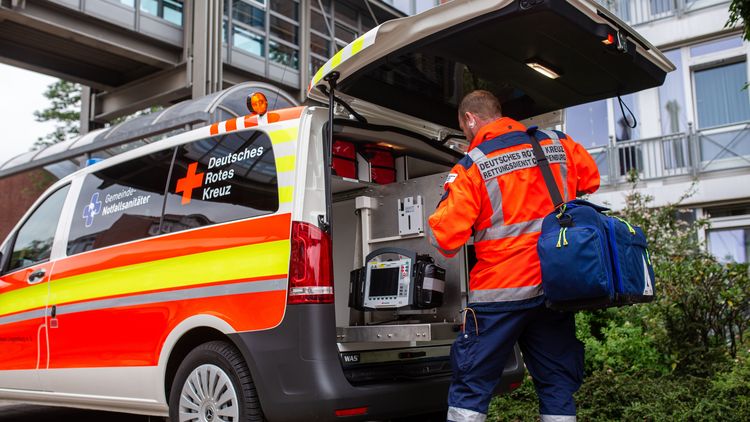If you dial 112 for the emergency medical services in the Oldenburg area, the dispatchers of the Oldenburger Land or Vechta Rescue Control Centre won’t always send an ambulance. Since the pilot project Gemeindenotfallsanitäter (Community Paramedics) was launched five years ago, they may decide to send a specially trained paramedic instead. Insa Seeger, a health services researcher at the University of Oldenburg, is investigating the impact of this new medical service on healthcare in the region. Her expertise is in growing demand among policymakers.
Dozens of times every day, emergency medical dispatchers make crucial decisions based on the calls they receive. Are the symptoms of the person on the line serious enough to warrant an ambulance? Or is it perhaps a less urgent case that would be better served by a general practitioner? If so, sending an ambulance would not only be unnecessary but would also mean that this important resource would be temporarily unavailable for a real emergency.
Since 2019, employees at the Rescue Control Centres involved in the Gemeindenotfallsanitäter project have had an additional option: they can deploy Community Paramedics who drive minivans fitted with medical equipment and are trained to provide on-site medical assistance independently. The goal is to ease the pressure on emergency departments and ambulance crews.
Health services researcher Dr Insa Seeger probably knows better than anyone else whether the concept is working. Although she is not present when the paramedics respond to a call, together with other researchers she has analysed thousands of deployment protocols over the last few years. Seeger (46) is a research associate at the Department of Health Services Research and spokesperson for the Oldenburg Research Network for Emergency and Intensive Care Medicine. She has provided scientific support for the project from the outset. “Our task is to analyse the impact of the community paramedics objectively and from an external perspective,” says the researcher, who studied Business Administration in Healthcare Facilities after training as a medical assistant and completed a doctorate on outpatient emergency care in Germany in 2019.
The Community Paramedic pilot project was launched in that same year as the only one of its kind in Germany at the time. Other participants in the project aside from the municipal authorities and Rescue Control Centres are the Malteser aid agency, the German Red Cross Cloppenburg, the City of Oldenburg’s fire brigade, the Ministry of the Interior of Lower Saxony, the statutory health insurance companies and the University Medicine Oldenburg. Just over a year after its launch, Seeger was already able to provide an analysis of the community paramedics’ deployments, which have changed only minimally in the intervening years. In most cases (more than 60 percent) the paramedics conclude that the patient “is not in urgent need of medical assistance”. This means that neither rapid medical intervention nor a hospital examination are necessary. Instead, the paramedics offer medical guidance, administer medication or provide support with self-medication, and check vital signs such as blood pressure and blood oxygen. “All these calls would otherwise involve the deployment of an entire ambulance team which is then no longer available for a real emergency situation,” Seeger explains. In around one in three cases the paramedics recommend that patients go to the emergency room. Only rarely does the situation turn out to be more serious than the dispatcher had assessed it to be, in which case the community paramedic immediately begins emergency treatment, calls for telemedicine guidance from Oldenburg Hospital if necessary, or summons backup via the Rescue Control Centre.
Seeger’s first study already showed that more than half of the patients were older than 65, so this group became the main focus of the researchers’ attention in following studies. “The Community Paramedics are able to provide the necessary assistance to more than half of the patients on site. This is a big advantage for older people in particular,” explains Seeger. After all, the often long wait times for treatment at an emergency department or inpatient admission can be very stressful, especially for the elderly.
Another key finding is that emergency calls are often made to emergency medical services which are not qualified or equipped to deal with the situation in question. Roughly one in seven of the elderly people to whom the community paramedics are deployed are in a nursing home – and with conspicuous frequency the reason for the call is a problem with a indwelling urinary catheter. Unlike regular paramedics, the community paramedics can provide immediate assistance in such cases. They learn how to handle catheters as part of their specialist training. By contrast, ambulance services tend to take such patients straight to hospital for further treatment.
Between outpatient care and standard emergency medical services
“Nationwide, we can see that Rescue Control Centres are receiving more and more calls that are not actual emergencies,” says Seeger. Her own research has shown that only a very small proportion of those who call the emergency services and to whom the community paramedics are then dispatched tried to contact their own doctor or the medical on-call service beforehand. Instead, they immediately dialled 112, thus putting themselves on the radar of the emergency services.
Precisely because the new service closes the gap between outpatient care and traditional emergency medical services, it cannot be clearly assigned to either of these two separate care sectors. According to Seeger, this is one of the main reasons why the project has not yet become a standard care service. Among other things, this classification process would determine how the cross-sector service is legally regulated and ultimately also how it is financed.
Consequently, the project is a recurrent topic of political debate. This has not gone unnoticed by Seeger, whose scientific expertise on the subject is increasingly sought after – by municipal authorities that are interested in the project and in some cases have already adapted it for their purposes. But also by politicians. She was recently invited by the Committee for Internal Affairs and Sport of the Lower Saxony state parliament to give an expert opinion on a draft law amending the Emergency Services Act. Seeger also regularly reports on the experiences with community paramedics at conferences for the emergency services sector.
Building on the results of her research so far, the study “Deployment, Services and Effects of the Community Paramedic” has also focused attention on the impact of this new emergency resource on the healthcare system in recent years. A team of researchers from various departments at the University of Oldenburg and other universities worked together to evaluate not only the paramedics’ protocols, but also data from rescue control rooms, ambulance services and emergency departments. The objective was to analyse how the services provided by the community paramedics impact other medical emergency service providers. general practitioners and patients were also given the opportunity to describe their experiences with the paramedics. At the time of going to press, the results of the three-and-a-half-year study had not yet been published.
“However, we can already say that the patients included in the survey were very satisfied with the care provided by community paramedics,” Insa Seeger emphasises.
This feedback reaffirms Seeger’s opinion that it makes sense to continue the pilot project: “The goal is to ensure that everyone seeking medical assistance receives appropriate care without wasting resources – and community paramedics can certainly contribute to this.”



